ExoMars
Latest
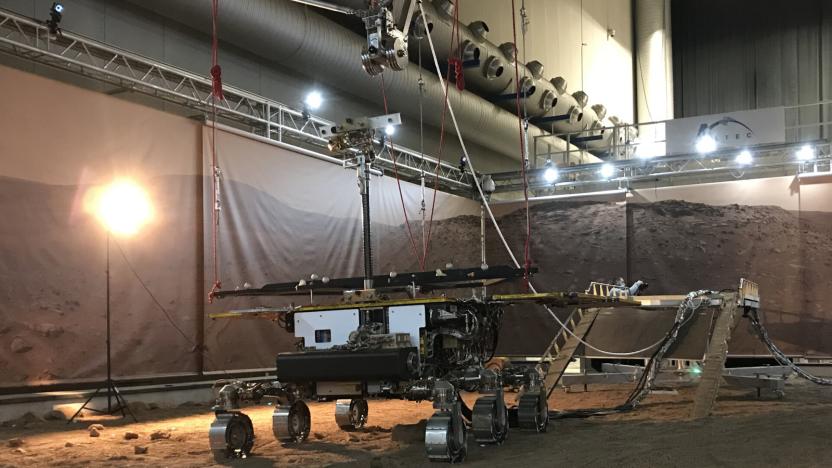
The ESA suspends its ExoMars joint mission with Russia
It's now looking for a way to proceed with the mission without Roscosmos.

ESA says ExoMars launch this year is 'very unlikely'
The joint project with Russian space agency Roscosmos will look for signs of life on Mars.
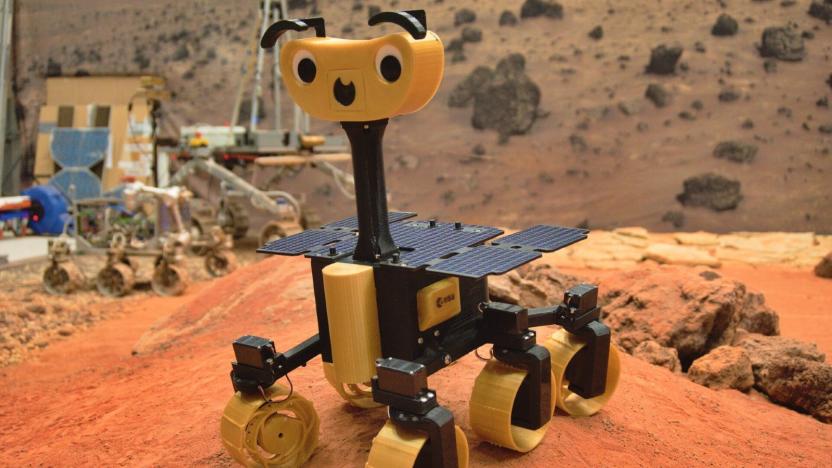
The ExoMy is a programmable $600 Mars rover you can build yourself
From Sojourner to the much bigger Curiosity, robotic rovers tend to come in all shapes and sizes, but few will go down as adorable as the European Space Agency’s new ExoMy rover.

The ExoMars rover mission has been postponed until 2022 for further testing
The ExoMars mission to carry a rover to the red planet will not launch this year as planned, according to the European Space Agency (ESA) and Russia's Roscosmos. The agencies announced that several components of the spacecraft, particularly the parachutes, still need testing. That means they'll miss the planned 2020 launch window and will need to wait for the next opportunity happening sometime between August and October 2022.

Second failure of ExoMars parachute test throws schedule in jeopardy
A joint mission between the European and Russian space agencies to deliver a rover to Mars is facing another setback. The European Space Agency (ESA) confirmed that parachutes for the ExoMars lander mission failed a second test that was conducted last week. A similar trial conducted back in May on the same parachutes also ended up malfunctioning. Scientists observed damages in the canopy in both cases.

Dust storms may have stolen all of Mars' water
In May 2018, Opportunity had been doing science on Mars since 2004, and there was no reason to think that the plucky rover wouldn't carry on. Then, a dust storm hit that completely obscured the planet from view. After fine dust coated Opportunity's solar panels, the rover apparently lost power and was declared dead by NASA in February 2019. Now, scientists think similar storms may have also delivered a coup de grace to water on Mars, stripping it from its surface for good.
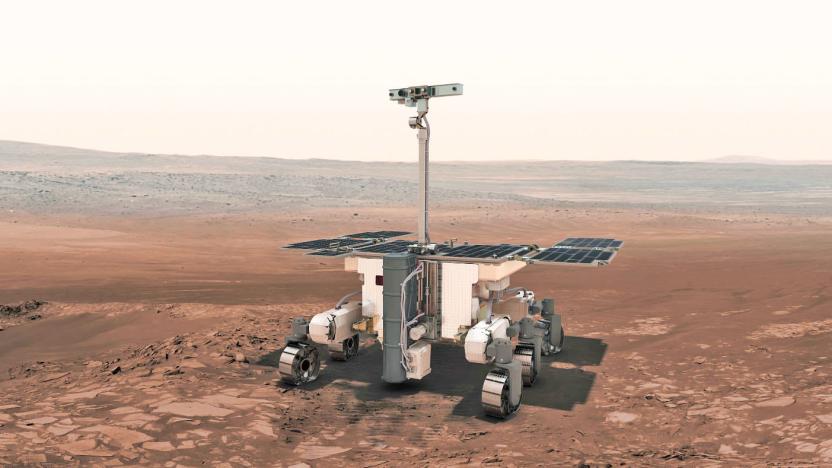
The ExoMars rover may search for life near the Red Planet's equator
Europe and Russia's ExoMars rover has been assigned its destination on the Red Planet. The robot explorer will almost certainly land on Oxia Planum -- a site rich in iron-magnesium clays near the equator -- say scientists from the Landing Site Selection Working Group (LSSWG) in Leicester, UK. They've been discussing touchdown options for around four years and -- with the blessings of the European and Russian space agencies -- this could be the spot. Unless, of course, they change tack and opt for the other site in contention: Mawrth Vallis, which lies just north of Oxia, reports the BBC.

Mars trips may involve less radiation exposure than previously thought
There's no question that the first human mission to Mars will be extremely dangerous. Some studies have suggested that the radiation levels would exceed the maximum career dose for a given astronaut, greatly increasing the risk of cancer and other illnesses. It might not be quite so bad as it sounds, though. Newly presented ESA ExoMars orbiter data indicates that astronauts would receive "at least" 60 percent of their maximum recommended career radiation exposure on a round trip to Mars that takes six months both ways. That's still several times what ISS crew members receive, but it's relatively gentle compared to what some had feared.

ESA tests its giant Mars mission parachute
The European Space Agency has put one of ExoMars' landing parachutes to the test for the first time. And while it was deployed from a helicopter merely less than a mile above the ground, its successful descent is a major milestone for the mission. The ESA's test focused on the project's second main parachute, the largest to ever fly on a Mars mission with a diameter of 115 feet. It's also one of the two designed to safely deliver the ExoMars rover and science platform to the surface of the red planet in 2021.

Doomed Mars lander wasn't equipped for supersonic conditions
Last October, the European Space Agency (ESA) lost contact with the ExoMars Schiaparelli lander as it descended to Mars' surface. A few days later, the NASA Mars Reconnaissance Orbiter snapped a picture of Schiaparelli's landing site and discovered where the lander crashed into the planet's surface. Now, an ESA inquiry board has finally pinpointed the cause of Schiaparelli's landing failure: a computer glitch due to extreme descent conditions.

ESA will fund ExoMars 2020 despite Schiaparelli's demise
The ExoMars mission will live on despite the Schiaparelli's lander unfortunate mishap. At a meeting in Switzerland, European Space Agency's member countries have agreed to set aside €436 million ($464 million) to make ExoMars 2020 a reality. That's the second part of the mission that arrived on Mars this year, and it aims to land a rover on the red planet in 2021 to drill into the Martian surface and extract samples from various depths.

ESA tests ExoMars orbiter's cameras and instruments
ExoMars might have lost the Schiaparelli lander, but the mission is far from being a failure: its Trace Gas Orbiter probe is working just fine. The probe spent two orbits, from November 20th to the 28th, making calibrations and testing out its instruments and its cameras. Since TGO's main purpose is to monitor rare gases on the red planet, its Atmospheric Chemistry Suite sniffed out carbon dioxide during the test run, while the Nadir and Occultation for Mars Discovery instrument focused on finding water vapor. The ESA has confirmed that both of them are capable of doing their jobs.

Mars probe crashed because it misjudged where the ground was
The European Space Agency believes that it knows what caused its Schiaparelli lander to crash on the surface of Mars. It turns out that the spacecraft was hurtling towards the ground perfectly well until it, uh, forgot where the ground actually was. A sensor tasked with determining its altitude failed for a single second, but that was long enough to wreck the entire mission. Since the vessel believed that it had already arrived, it ran through the rest of the landing process and activated the on-ground sensors.

ESA releases first color photos of the EXOMARS crash site
The ESA's EXOMARS Schiaparelli lander crashed into the Red Planet's crust at more than 300 kph on October 19th, marking not only the end of its mission but also the surface itself. NASA's Mars Reconnaissance Orbiter (MRO) spotted the impact site quickly afterward but it wasn't until this week that its orbit brought the MRO back around. Using its High Resolution Imaging Science Experiment (HiRISE) camera, the MRO snapped the shot you see above.
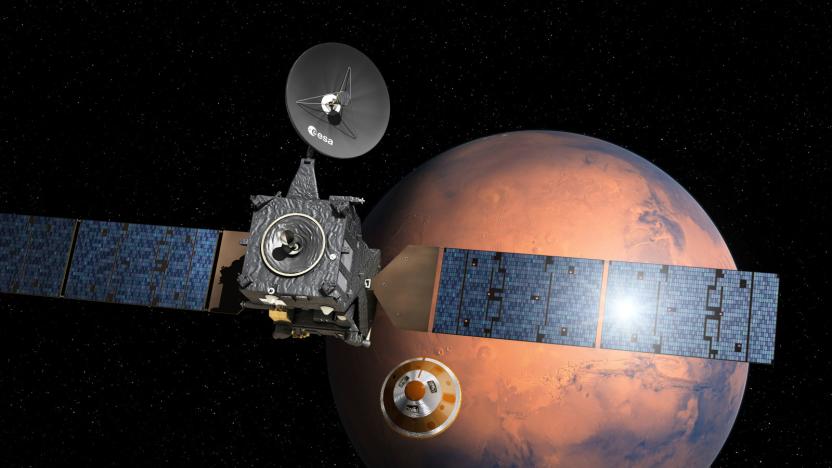
NASA finds likely crash site for ESA's ExoMars probe
Just as we expected, NASA's Mars Reconnaissance Orbiter (MRO) has detected the potential crash site for the European Space Agency's missing ExoMars Schiaperelli probe. The MRO located a bright spot and dark patch on the Martian surface near the probe's planned landing area, which NASA believes to be the remnants of the probe's parachute and lander module, respectively. While we've only got a fairly low-resolution image so far, we should know more next week when the MRO passes over the area again with a higher resolution camera.
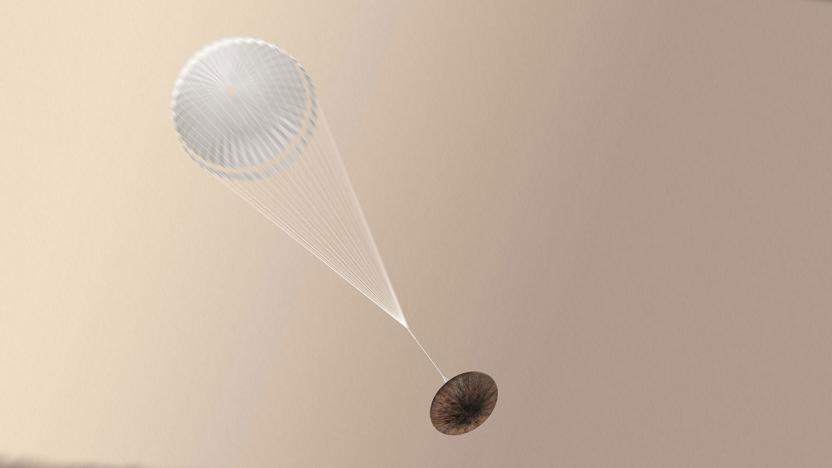
The ESA's ExoMars mission lander is still missing
The European Space Agency is still in the midst of investigating what happened to ExoMars' Schiaparelli lander, which seemed to disappear 50 seconds before it was supposed to land. At the presscon the agency held earlier, Andrea Accomazzo, ESA's head of planetary missions, said the ExoMars team already downloaded the data Schiaparelli sent to its mothership before it vanished. Unfortunately, we'll have to wait a bit more to get the whole picture, because it'll take some time to analyze the information.

The ESA's ExoMars mission looks like a success so far (Updated)
After a seven-month trip, the European Space Agency announced on Wednesday that its Schiaparelli module, ExoMars mission's landing craft, has deployed to the surface of Mars. The module jettisoned itself from its partner craft, the Trace Gas Orbiter, at approximately 10am ET and set down to the planet shortly thereafter. ESA Operations has not, however, yet confirmed that the lander survived its drop to the surface.

The European Space Agency will land on Mars in October
Nearly 13 years after the British spacecraft Beagle 2 went missing on Mars, the European Space Agency's Schiaparelli module will touch down on the red planet -- assuming everything goes according to plan, that is. The module, which launched with the ExoMars Trace Gas Orbiter in March, will serve primarily as a test bed for the descent and landing systems and is expected reach the surface on October 19th.

Europe and Russia move their ExoMars mission launch to 2020
While the first part of Europe's and Russia's ExoMars mission took off on time in March, the second phase has been delayed. They've decided to launch their Martian rover, which will be capable of drilling up to two meters (6.5 feet) below the surface, in 2020 instead of 2018 like they previously planned. According to the BBC, Roscosmos' engineers have been having a hard time designing rover's landing mechanism. At the same time, European Space Agency's engineers are also having trouble putting together all the components and instruments ExoMars' second phase needs.
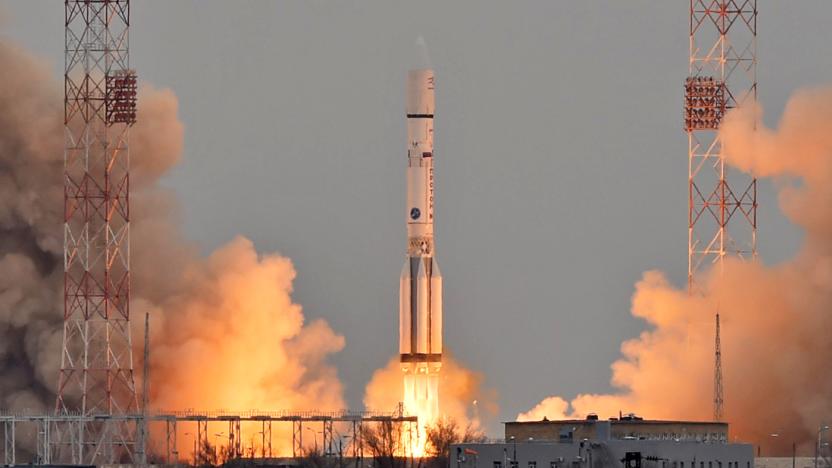
ExoMars is speeding toward the red planet
In 2013 the European and Russian folks behind ExoMars announced they'd launch a rocket to explore Mars this year and they're right on schedule. Lifting off from Kazakhstan this morning, the spacecraft now has a seven month journey to the Red Planet where the Schiaparelli module will test its entry, descent and landing tech that'll be used on future missions. Once on the surface it'll start doing environmental analysis and hopefully avoid a turf selfie war with our Curiosity rover. Its "short" surface mission involves measuring electrical fields that should give insight into what triggers Martian dust storms.










